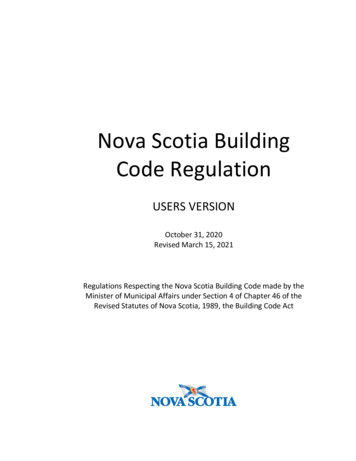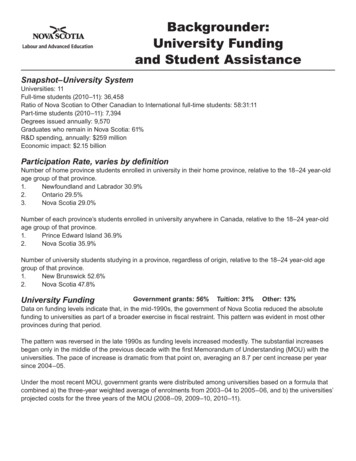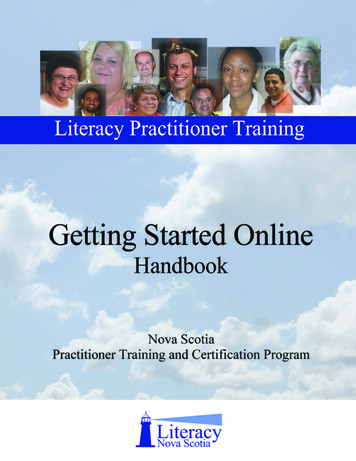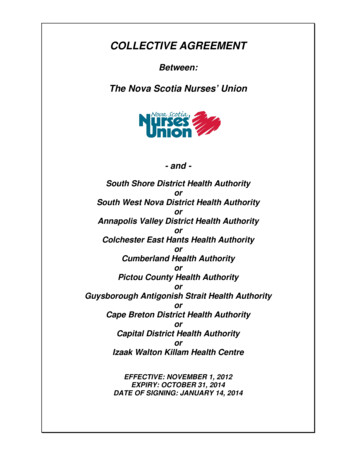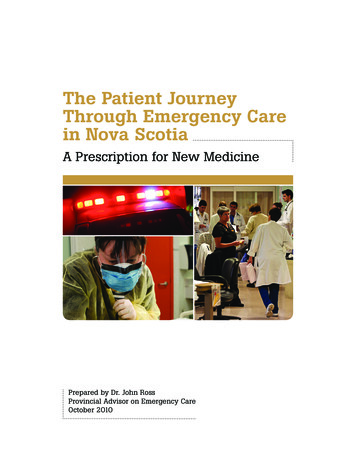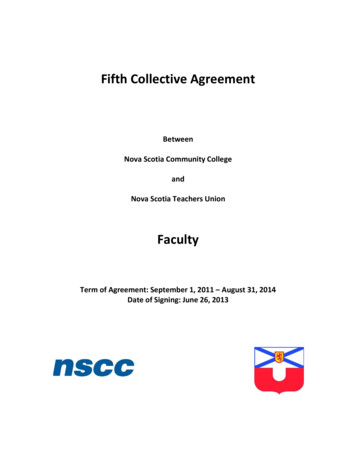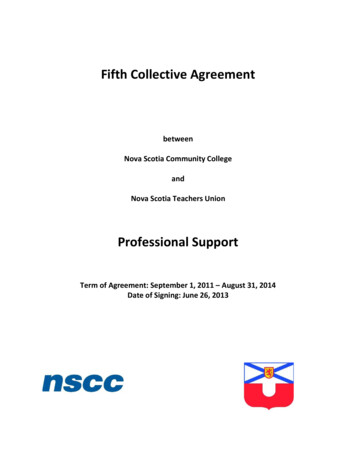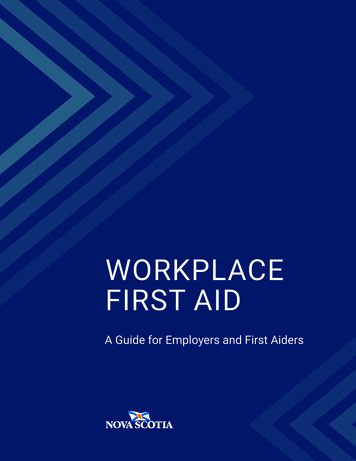
Transcription
WORKPLACEFIRST AIDA Guide for Employers and First AidersWorkplace First Aid: A Guide for Employers and First Aiders
About this guideThis guide provides general information for educational purposes only.The wording may differ from the actual laws and regulations. Use officialsources when interpreting the law. This document is not intended toreplace the Occupational Health and Safety Act or the regulations.For official sources, refer to the Workplace Health and SafetyRegulations, N.S. Reg. 52/2013, specifically Part 4: First Aid. Forworkplace first aid requirements that apply to underwater diving, pleaseconsult the Occupational Diving Regulations, N.S. Reg. 174/2005. Forfirst aid requirements that apply to underground mining operations,please consult the Underground Mining Regulations, N.S. Reg. 296/2008amended to N.S. Reg. gs/ohsworkplace.htm Crown copyright, Province of Nova Scotia, 2022
1IntroductionEveryone has a right to feel safe and supported in the workplace.In Nova Scotia, we have workplace first aid regulations to ensurethat we will promptly receive emergency care if we are injured atwork. This care can minimize injury and the possibility of futuredisability. It can also mean we will recover more quickly. In the mostserious cases, first aid may keep us alive until professional medicalcare arrives.We all have a role to play in keeping each other safe in theworkplace. This document explains the first aid requirements NovaScotia employers must provide in the workplace, such as what firstaid equipment must be available, how many first aiders should beonsite, what training those first aiders should have, and how to writea workplace first aid plan.It also provides information for first aiders about how toachieve certification.It is not a replacement for the regulations. We recommend you readthe full regulations to understand everything they contain.Aligning with the Accessibility Act of Nova Scotia employers shouldensure that first aid supplies are easily accessible for all workplaceparties including those with physical and other disabilities. Pleaseensure your supplies are within reach for all s/ohsworkplace.htmWorkplace First Aid: A Guide for Employers and First Aiders
2 Workplace First Aid: A Guide for Employers and First Aiders
3ContentsIntroduction1Section 1 Information for Employers51.11.21.31.41.5First aid kitsHow many do you need?Where should you keep them?ContentsFirst aiders and other medical professionalsHow many first aiders do you need?When can you substitute medical professionals for first aiders?Transportation and first aid roomsHow many first aid kits and first aiders do you need at each workplace?How to find the number of employees at a workplaceHow to determine your type of workplaceHow to determine the travel time to emergency servicesPolice and firefightersDo you need more than the minimum?Record keepingChecklist556667777991010111111Section 2 Information for First Aiders122.1 CertificationTraining and certification renewalHow long does it take to become certified or to renew a certification?1212132.2 Record keeping13Workplace First Aid: A Guide for Employers and First Aiders
4Section 3 First Aid Rooms3.1 Do you need a first aid room?3.2 Who is responsible for the first aid room?3.3 What is required in a first aid room?Section 4 Isolated Workplace First Aid Plan4.1 Do you need an isolated workplace first aid plan?4.2 What to include in your written isolated workplace first aid plan14141415161718Definitions19Appendix A First Aid Compliance Worksheet20Appendix B Employer first aid checklist23Appendix C Types of first aid kits and their contents24 Workplace First Aid: A Guide for Employers and First Aiders
5Section 1 Information for EmployersAs an employer, you must provide first aid supplies, trained first aiders, and other first aidservices, such as emergency transportation, at each of your workplaces at your own expense.Note: If your workplace has several employers represented onsite at once, you can enter into awritten agreement with the other employers to either collectively supply the first aid requirements have one employer supply them for everyoneThis section covers1.1first aid kits1.2first aiders and other medical professionals1.3transportation and first aid rooms1.4how to determine the number of first aid kits and first aiders you need1.5record keeping1.1First aid kitsNova Scotia has approved three types of first aid kits for use in Nova Scotia workplaces:Type 1 – Personal first aid kit. Available in only one size.Type 2 – Basic first aid kit. Available in three sizes (small, medium, large).Type 3 – Intermediate first aid kit. Available in three sizes (small, medium, large).Tip: Look for the Canadian Standards Association (CSA) logo to know you are buying anapproved first aid kit.How many do you need?The type, size, and number of kits you will need depends on three factors: how many employeesare in your workplace, whether your workplace is an office or not, and how far away you arefrom emergency medical services. See Table 1 in section 1.4 to determine your needs.Your first aid kit(s) must meet current regulations, which came into force on June 13, 2022 Youhave one year to bring any old kits up to code.Workplace First Aid: A Guide for Employers and First Aiders
6Where should you keep them?Your kits should be accessible at all times during workplace hours. Keep them in a clean,dry location.If you have more than one, distribute them throughout the workplace so they can be reachedquickly. Make sure you have clear signage indicating where they are, and include the name andphone numbers of any first aiders you have on staff.ContentsDifferent types of kits have different contents. See Appendix C for a full list of items that come ineach type of kit. Check your kits regularly to make sure they are clean and dry fully stocked with no expired items visible and in accessible locations in line with the regulationsNote: If you have identified hazards that are unique to your workplace, you may need extra itemsthat are not included in a first aid kit. For example: products that treat chemical burns to theskin or eyes are not standard in first aid kits. You will need to have appropriate first aid suppliesavailable based on the hazards in the workplace.1.2First aiders and other medical professionalsFirst aiders are employees at the workplace who are trained and certified to promptly provideinjured employees with a level of care within the scope of practice appropriate for their level ofworkplace first aid training.First aiders are certified at three levels: basic, intermediate, or advanced. See section 2.1 formore information on certification.As an employer, you must ensure the training your first aiders take meets the requirements in the latest version of CSAStandard Z1210 pay the cost of your first aiders’ training give them the time off to take the training pay them their regular wages and benefits while they are taking the training keep a copy of each first aider’s certificate until it expires. Certification is good for a maximumof three years. Check with your training agency as some may specify a shorter period. Workplace First Aid: A Guide for Employers and First Aiders
7Electronic certificates are acceptable.How many first aiders do you need?The number of first aiders you will need, and their level of certification, depends on threefactors: how many employees are in your workplace, whether your workplace is an office or not,and how far away you are from emergency medical services. See Table 1 in section 1.4 to findthe minimum number of trained first aiders required in your workplace.When can you substitute medical professionals for first aiders?If your workplace is a hospital* emergency care facility* or long-term care facility* you cansubstitute a medical professional for a workplace first aider if the medical professional has current CPR training and is available for first aider duties during all shiftsSee definitions page 19.*For workers who have first aid or medical training but do not work in a hospital, emergencycare facility, or long-term care facility, the training must meet the minimum requirements of theCSA Z1210 workplace first aid standard.1.3Transportation and first aid roomsAs an employer, you must also provide safe and timely emergency transportation to a hospitalor emergency care facility.Along with first aid kits and first aiders, you may also need to provide one or more first aidrooms. See section 3 to determine if you need a first aid room.1.4How many first aid kits and first aiders do you need ateach workplace?The number and type of first aid kits you need, as well as the number of first aiders and theircertification levels depends on three factors:1. the number of employees at the workplace during each shift2. the type of workplace (office or other)3. the travel time to emergency servicesUse table 1 to determine your needs. You can also use the compliance worksheet in Appendix A.Workplace First Aid: A Guide for Employers and First Aiders
8Table 1: Number of first aid kits and first aiders required in Nova Scotiaworkplaces based on number of employees per shift, type of workplace(office or other), and surface travel time to emergency servicesOfficesNumber ofNumber offirst aiders &employeescertificationSurfaceper shiftleveltravel time1—Close2-251 basicworkplace26-501 basic20 minfrom51-991 basicemergency100-1992 basicmedical200 orcare3 basicmore1Distant2-251 basicworkplace26-501 basic20-40min from51-991 basicemergency100-1992 basicmedical200 orcare3 basicmore11 basic2-251 basicIsolated26-501 basicworkplace40 minfrom51-992 basicemergencymedical100-1992 basiccare200 or3 basicmoreOther workplaces1 type 11 type 2 (small)2 type 2 (small)3 type 2 (small)6 type 2 (small)Number offirst aiders &certificationlevel—1 basic1 Intermediate2 Intermediate2 Intermediate1 type 11 type 2 (small)2 type 2 (small)3 type 2 (small)6 type 2 (small)6 type 2 (small)3 Intermediate6 type 2 (small)1 type 11 type 2 (small)2 type 2 (small)3 type 2 (small)6 type 2 (small)1 type 11 type 2 (small)2 type 2 (small)3 type 2 (small)6 type 2 (small)1 type 11 type 2 (small)1 basic1 intermediate1 intermediate2 intermediate1 intermediate2 intermediate1 advanced1 intermediate1 intermediate2 type 2 (small)1 advanced3 type 2 (small)2 advanced6 type 2 (small)3 advanced6 type 2 (small)4 advancedNumber andtype offirst aid kits6 type 2 (small)Number andtype offirst aid kits6 type 2 (small)1 type 11 type 3 (small)1 type 2 (small)1 type 3 (small)2 type 2 (small)1 type 3 (small)4 type 2 (small)2 type 3 (small)6 type 2 (small)Note: Kit sizes can be replaced based on one medium kit being equivalent to two small kits; andone large kit being equivalent to four small kits. Workplace First Aid: A Guide for Employers and First Aiders
9How to find the number of employees at a workplaceInclude all full-time, part-time, and casual employees that are in the workplace on any one shift.If employees come and go during a shift, use the maximum number of employees presentduring that shift to determine your needs.If any one shift (for example, the night shift) has fewer employees than another (for example,the day shift), you may need fewer first aiders with a different level of certification for that shift.Employees who work alone must have a first aid kit. Employees who work apart from eachother (for example, on a large farm) are treated as if they work alone and are required to have afirst aid kit. See Table 1 for the type and size of kit needed (depending on type of workplace anddistance from medical services). Employees who work from home in a home office do not needto be provided with a first aid kit.How to determine your type of workplaceUnder Nova Scotia’s current Workplace Health and Safety Regulations, there are two typesof workplaces:Office Administrative, professional, or clerical work only No substantial physical exertion No exposure to potentially hazardous processes, substances, or other conditionsOther All workplaces that are not offices“Other” workplaces include mobile workplaces. These may be either a private or a companyowned/operated vehicle or mobile equipment, as well as boats and aircraft.Use the maximum seating capacity of the vehicle or mobile equipment to calculate the numberand type of first aid kits and first aiders required. Solitary drivers require at least one type 1 firstaid kit regardless of travel time to emergency services.Workplace First Aid: A Guide for Employers and First Aiders
10How to determine the travel time to emergency servicesYour workplace will be considered either close, distant, or isolated based on the time it takes under normal circumstances to transport an injured employee by surface*from the workplace to a hospital** or emergency care facility** or the time required under normal circumstances for Emergency Health Services (EHS)** toarrive at the workplaceSurface travel time includes travel by land or water under normal conditions.See definitions page 19***Close:Distant:Isolated:20 minutes or lessMore than 20 minutes but less than 40 minutes40 minutes or moreSee Table 2 for estimated response times.Table 2: Guide for estimating EHS’s response time for urgent cases.Population sizeMore than 15,0002,500 to 14,999Less than 2,500Time9 minutes15 minutes30 minutesSource: Based on EHS response time performance standard for first ambulance to arrive at thescene, 90 per cent of the time (December 2020).Police and firefightersThe response time estimates provided here do not include response time by police orfirefighters. Police officers and firefighters have first aid training; however, police officers do nottypically have automated external defibrillators (AEDs), which are used to treat people having asudden cardiac arrest.Your local fire department may have an AED. We suggest you confirm the services andequipment your local fire department can provide. EHS has created an online registry of AEDs inNova Scotia that is available to the public. Check this interactive map (figure 1) to find the AEDnearest you. https://savelivesns.ca/ehs-interactive-aed-map/. Workplace First Aid: A Guide for Employers and First Aiders
111.5Record keepingEmployers must keep detailed records of every injury in your workplace. Your first aider will fillout the actual record, which must include the name of the injured person the date and time of the injury the location and nature of the injuries on the person’s body the time when first aid was administered the first aid treatment provided the name of the person who provided the first aid and the workplace first aidcertificate they hold the name of the person the injury was reported toChecklistWe encourage you to consult your organization’s joint occupational health and safetycommittee or your health and safety representative to reduce the risk of harm in your workplaceand prevent injuries and illnesses before first aid measures are needed.Use the employer checklist in Appendix B to ensure you have the right number and type of firstaid supplies and trained people for your workplace.Workplace First Aid: A Guide for Employers and First Aiders
12Section 2 Information for First AidersAs a first aider, you are trained and certified to promptly provide injured employees with a levelof care within the scope of practice appropriate for your level of workplace first aid training.The section covers2.1 certification2.2 record keeping2.1CertificationNova Scotia recognizes three levels of first aid certification under the Workplace Health andSafety Regulations: basic, intermediate, and advanced. The level of certification you require willbe determined by the number of employees on any one shift at the workplace the type of workplace (office or other) whether the workplace is close to, distant from, or isolated from emergencymedical servicesSee Table 1 on page 8 for which certification levels are required and when.Note: If you were certified as having emergency (now called basic), standard (now calledintermediate), or advanced (still called advanced) first aid skills under the Occupational Healthand Safety First Aid Regulations (2001), your certification remains valid until it expires.Training and certification renewalYour employer must pay for your training to become certified or to renew your certification.They must also give you the time, with pay, to take it. You can choose where you take yourtraining but it must be given by an approved training agency that adheres to the requirements ofCSA Standard Z1210 “First aid training for the workplace – Curriculum and quality managementfor training agencies.”Certification is good for a maximum of three years. Check with your training agency as somemay specify a shorter period. Workplace First Aid: A Guide for Employers and First Aiders
13How long does it take to become certified or to renew a certification?First aid training that meets the CSA first aid training standard includes a combination ofclassroom learning and practical skills demonstration. Training times are the same whether youare taking the training for the first time, or renewing an expired certification.Length of training courses: basic – approximately one day (7 hours) intermediate – approximately two days (14 hours) advanced – approximately 10 days (70 hours)First responders may require first aid training that is different from the minimum required fora workplace first aider. If you require extra training, look for a training agency that can tailor acourse for your needs.2.2Record keepingAs a first aider, you will create a written record every time you give first aid to an injured personat the workplace. This record must include the name of the injured person the date and time of the injury the location and nature of the injuries on the person’s body the time when first aid was administered the first aid treatment provided the name of the person who provided the first aid and the workplace first aid certificatethat they hold the name of the person the injury was reported toYour employer is responsible for maintaining these records. All employees have a responsibilityto promptly report workplace injuries to their employer.Workplace First Aid: A Guide for Employers and First Aiders
14Section 3 First Aid RoomsA first aid room is a room at a workplace that is used exclusively for administering first aid.Having a first aid room does not replace your requirement to have first aid kits and first aiders,as listed in the regulations.This section covers3.1 when you need a first aid room3.2 who is responsible for maintaining the first aid room3.3 requirement of a first aid room3.1Do you need a first aid room?As an employer, you must provide at least one first aid room if your workplace is not an office, and you have 200 or more employees regularly employed on any one shift at the workplace,and your workplace is not a hospital* emergency care facility* or long-term care facility*See definitions page 19*3.2Who is responsible for the first aid room?The employer is responsible for controlling and supervising the first aid room, ensuring it is accessible during working hours, clean, heated, well ventilated, and well lit has an entrance big enough to accommodate a stretcher has a means of communicating with the other areas of the workplace has emergency telephone numbers posted has appropriate first aid supplies that meet the regulations, including a bed (see page 15) Workplace First Aid: A Guide for Employers and First Aiders
153.3What is required in a first aid room?Equipment and furniture 1 sink with running water 1 refuse pail with a cover 1 chair with arm rests that ensure that the chair is suitable to treat injured employees 1 bed, covered with a plastic sheet pillows and blankets 1 cabinet suitable for storing dressings and InstrumentsMaterials and supplies 1 first aid guide 12 assorted safety pins 1 roll of tubular finger bandages with applicator 1 wash basin 1 package of paper towels hand soap 1 package of disposable paper cups 1 kidney basin 1 set of assorted splints 1 portable medium size type 2 first aid kit, as prescribed by the latest version of CSAStandard Z1220, “First aid kits for the workplace” supplies equivalent to those in a large size type 2 first aid kit 1 flashlight 20 additional pairs of disposable latex gloves or gloves made of material that provides anequivalent level of protection against the spread of infections or contagious conditions instructions on how to record first aid treatments 1 pencil 1 bottle of an adequate antiseptic (at least 100 ml)Workplace First Aid: A Guide for Employers and First Aiders
16Section 4: Isolated workplace first aid planA workplace is considered to be isolated if the surface travel time under normal circumstances to transport an injured employee fromthe workplace to a hospital or emergency care facility takes more than 40 minutesor the time required under normal circumstances for EHS to arrive at the workplace takesmore than 40 minutesIf your workplace fits that description, you may need to have a written isolated workplacefirst aid plan.The section covers4.1 How to determine if you need an isolated workplace first aid plan4.2 What to include in your plan Workplace First Aid: A Guide for Employers and First Aiders
174.1Do you need an isolated workplace first aid plan?Follow this flow chart to determine if you need an isolated workplace first aid plan:Question 1How much time doyour employees spend,measured over a fourweek period, at theisolated workplace?Less than 10 per centSTOPMore than 10 per centYou do NOT needa written isolatedworkplace first aid plan.Continue to question 2Question 2Which of the following apply toyour workplace?If all five ofthe conditionsabove are metCheck all that apply:o1. An employee spendsmore than 10 per cent butless than 25 per cent oftheir time at the isolatedworkplace over afour-week periodo2. An injured person canbe transported from theisolated workplace tothe closest emergencycare facility within areasonable timeIf any oneof the fiveservices areNOT providedo3. There is a means oftransport at the isolatedworkplace for aninjured workero4. There is a means ofsummoning assistanceavailable at the isolatedworkplaceo5. The workplace is an office.STOPYou do NOT needa written isolatedworkplace first aid plan.YouMUST HAVEa written isolatedworkplace firstaid plan.Workplace First Aid: A Guide for Employers and First Aiders
184.2What to include in your written isolated workplacefirst aid planYou must have an isolated workplace plan for each of your isolated workplaces. Be sureto consult your joint occupational health and safety committee or representative to createyour plan.Your plan must include a description of how each isolated workplace will comply with at least the minimumstandards set out in the regulations a method of transportation for injured employees from each isolated workplace a method of communication with and from each isolated workplace a description of the nature of the work being performed at each isolated workplace Workplace First Aid: A Guide for Employers and First Aiders
19DefinitionsEmergency Health Services (EHS): the arrangement of personnel, facilities, and equipmentrequired for the effective, co-ordinated delivery of services provided by registered pre-hospitalfirst responders and by paramedics and other medical professionals under the EmergencyHealth Services Act and required in the prevention and management of medical, trauma, andhealth conditionsEmergency Care Facility: a health-care facility that is equipped to provide immediate treatmentof injuries and illnesses AND has a medical practitioner on callHospital: a hospital as defined in the Hospitals Act that provides emergency services during allhours of operationLong-term Care Facility: a nursing home or a residential care facility as defined in the Homesfor Special Care ActMedical Professional: a medical practitioner registered and licensed under the Medical Act a nurse practitioner registered and licensed under the Nursing Act a registered nurse registered and licensed under the Nursing Act a licensed practical nurse registered and licensed under the Nursing Act a paramedic who is licensed under the Paramedics ActWorkplace First Aid: A Guide for Employers and First Aiders
20Appendix A First Aid Compliance WorksheetFirst Aid Compliance WorksheetBasic Information1.Name of workplace:Note: Please use a separate worksheet for each workplace1.2.How would an injured person be transferred from the workplace to a hospital or anemergency care facility?First Aid Kits and First Aider Training3.Is the workplace a hospital, emergency care facility, or long-term care facility?ooYES. An employer at a hospital, emergency care facility, or long-term care facility,which of the following substitutions will be made: a medical professional who maintains current training in cardio-pulmonaryresuscitation for a workplace first aider; medical supplies maintained at the workplace for a first aid kit if the suppliesinclude all of the items required by regulation; first aid supplies and facilities equivalent to those required in a first aid room for afirst aid room, as specified in regulation. Proceed to next question.NO. Proceed to next question. Workplace First Aid: A Guide for Employers and First Aiders
214.Is the workplace a vehicle? Note that the definition of “vehicle” includes boatsand aircraft.oo5.6.YES. Consider how many employees may require first aid in the vehicle at a giventime: If the work vehicle is regularly used to transport only the driver of that vehicle,then the driver’s employer must ensure that the vehicle has at least a type 1 firstaid kit. If the work vehicle is regularly used to transport employees in addition to thedriver, then the driver’s employer must ensure that the vehicle has at least a smalltype 2 first aid kit. Proceed to next question.NO. Proceed to next question.Number of employees per shift including full-time, part-time, and casual employeeso1o51 – 99o2-25o100 – 199o26 – 50o200 or moreSurface travel time to transport an injured employee from the place where they areinjured to a hospital or an emergency care facility, or for EHS to arrive and attend to aninjured employeeoClose: No more than 20 minutesoDistant: More than 20 minutes but less than 40 minutesoIsolated: More than 40 minutes17. Does the definition of “office”2apply to this workplace?oYES. See Table of Minimum First Aid Kit and First Aider Training Requirementsfor an OfficeoNO. See minimum first aid kit and training requirements in for “other workplaces”Workplace First Aid: A Guide for Employers and First Aiders
22ResultsNumber, type, and size of first aid kits:Number of first aiders and level of first aid training required:Transportation needs:Is a first aid room required?Is an isolated workplace first aid plan required?SignatureName:Signature:Date:Others consulted (joint occupational healthand safety committee; health andsafety representative):A written isolated workplace first aid plan must be prepared for each isolated workplaceunless otherwise specified in the Workplace Health and Safety Regulations (see “Noisolated workplace first aid plan required” for exceptions to the requirement for a workplacefirst aid plan).12“office” means a workplace that meets all of the following criteria:(i) the only work carried out at the workplace is of an administrative, professional orclerical nature;(ii) the work carried out at the workplace does not require substantial physical exertion orexposure to processes, substances or other conditions that are potentially hazardous tothe health and safety of persons at or near the workplace. Workplace First Aid: A Guide for Employers and First Aiders
23Appendix B Employer First Aid ChecklistComplete this checklist to help ensure compliance with the workplace first aid requirementso Find the number of employees per shifto Find the number of first aid services, supplies, equipment, and transportation (see theFirst Aid Compliance Worksheet in Appendix A)o Pay for first aider training that is provided by a training agency that meets the minimumrequirements of the Canadian Standards Association (CSA) first aid training standardo Pay wages for the time that employees need to attend first aid trainingo Keep a copy of first aid certificates and expiry dates (certificates may be digital)o Post the names, locations, and contact info for first aiders in a prominent location atthe workplaceo Ensure there are first aiders, or first aid services, available during all work hourso Ensure that first aid supplies are provided and remain accessible during working hourso Keep first aid supplies fully stocked, properly stored, in good condition, and current(not expired)o Keep a record of injured persons and the first aid services that are provided in the workplaceo Develop a plan to provide a safe and timely means of transporting an injured person fromthe workplace to a hospital or an emergency care facilityo If an employee is injured and requires assistance, allow another employee to accompanythe injured worker while being transported to a hospital or emergency care facilityo Train employees to promptly report all injuries to the employero Determine if you require an isolated workplace first aid plan and write one, if necessaryo When developing your isolated workplace first aid plan, consult your committee orrepresentative, if one existso Determine if you need a first aid roomo If a first aid room is required, ensure it is accessible during working hours and meets allrequirements under the regulationsWorkplace First Aid: A Guide for Employers and First Aiders
24Appendix C Types o
CSA Z1210 workplace first aid standard. 1.3 Transportation and first aid rooms As an employer, you must also provide safe and timely emergency transportation to a hospital or emergency care facility. Along with first aid kits and first aiders, you may also need to provide one or more first aid rooms.
